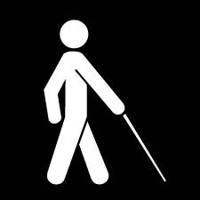NSF, Lions World, UALR Help Blind ‘See’
In 1931, the Lion’s Club International began a national program promoting the use of white canes to help the blind “see.” Now, scientists at UALR are turning to the organization to test a next generation “smart” cane — one that provide details and dimension to enable the sightless to navigate in an a physical environment.
 Dr. Cang Ye, associate professor of applied science in UALR’s Donaghey College of Engineering and Information Technology, recently received a nationally competitive research grant of $320,389 from the National Science Foundation’s Robust Intelligence Program to develop new computer vision methods and build portable blind navigational devices that may guide visually impaired people in unstructured environment.
Dr. Cang Ye, associate professor of applied science in UALR’s Donaghey College of Engineering and Information Technology, recently received a nationally competitive research grant of $320,389 from the National Science Foundation’s Robust Intelligence Program to develop new computer vision methods and build portable blind navigational devices that may guide visually impaired people in unstructured environment.
Once the device is built, Ye will partner with rehabilitation specialists at Lions World Services for the Blind — whose headquarters is next door to the UALR campus — and students at the Arkansas School for the Blind in Little Rock to help test the smart canes.
“There are no devices available that assist blind travelers in the way that Dr. Ye hopes the Smart cane will,” said Dr. Larry Dickerson, chief executive officer and president of Lions World Services for the Blind. “We are eager for him to develop a working prototype. We will evaluate its effectiveness and perhaps suggest refinements with the help of our clients who come from all over the United States and our experienced staff.”
Electronic white canes used by the blind have been around for several years. But Ye’s research hopes to vastly improved the “vision” with smart canes can provide the visually impaired people.
“The science of the project is to devise computer vision methods that may enable the Portable Blind Navigational Devices (PBNDs),” Ye said.
Ye and his team of researchers will use Flash LADAR (laser detection and ranging) (LADAR) 3-dimensional imaging sensor to provide the blind user a more detailed “picture” of a physical environment.
“We use a Flash LADAR 3D imaging sensor for perception,” he said. “The imaging sensor produces both intensity image and range image of its environment. Each pixel in the range image contains distance information of the corresponding pixel in the intensity image.”
His team has developed computer vision methods including an ego-motion estimation algorithm called VR-Odometry (VRO) and a 3D data segmentation method. The methods will be refined, validated through this project and their real-time implemention in the PBNDs will be achieved at the end of the project.
“The VRO estimates the sensor’s motion by simultaneously processing the intensity and range images. It will extract features in each two consecutive intensity images, match features of the two images, obtain the distance information of the matched features, and compute the change of the sensor’s position and orientation,” he said. “This method can provide ‘where am I?’ information to the blind.”
Electronic white canes used by the blind and visually impaired people have been around for several years. But Ye’s research hopes to create computer software that can detail where a staircase or a doorway is located in a room; where a drop off in the floor exists; or where an overhead bulkhead can be found. The core technology is 3D data segmentation. Once the program is created, it can be installed in a portable “cane” and provide information orally to a visually impaired person, who then can know the lay of the land.
“This is crucial navigational information that is difficult to obtain by using a conventional white cane,” Ye said. “The data segmentation method can also provide obstacle information such as an overhang obstacle or drop-off. The project’s hypothesis is that a single Flash LADAR sensor can solve blind navigation problems — avoiding obstacles and way-finding. Thus it is possible to build portable navigational device.”
The term “way-finding” refers to how blind people move toward a destination. Finding waypoints, such as stairways, hallways, and the awareness of his or her position contribute to the goal to move from one point to another.
The NSF grant will involve Ye, two graduate students and a number of undergraduate students at UALR’s EIT college. The initial study that led to the grant was supported in part by UALR’s Office of Research and Sponsored Programs, Arkansas Space Grant Consortium, Arkansas NASA EPSCoR Program, NISH, a nonprofit agency creating ;job opportunities for people with severe disabilities; the American Society for Engineering Education; and Office of Naval Research.
“We have Lion’s World Service for the Blind and Arkansas School for the Blind as our partners,” Ye said. “They will help us evaluate the devices and provide opinions to refine the devices during the project period.”
Throughout history, blind and visually impaired peoplehave used canes, staffs — even sighted people used sticks as traveling aids. From the biblical era shepherd’s staffs to the dapper walking sticks of the 19th century, canes have been used as tools for traveling.
In the early 1920s, a British photographer, blinded following an accident and uncomfortable with traffic around his home, painted his walking stick white to help the sighted take notice of him.
In 1931, the Lions Club International began a national program promoting the use of white canes for persons who are blind.
When the blind veterans of World War II returned to America, the form and the use of the white cane was further altered when Dr. Richard Hoover developed the “long cane” or “Hoover” method of cane travel.
These white canes, designed to be used as mobility devices, returned the cane to its original role as a tool for mobility, but maintained the symbolic role as an identifier of blind independence.